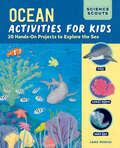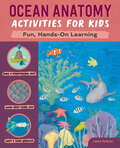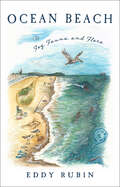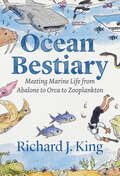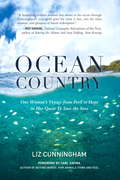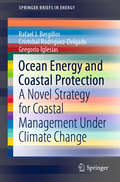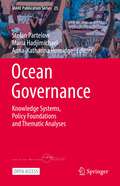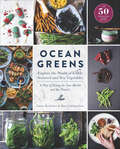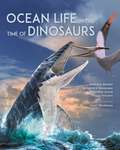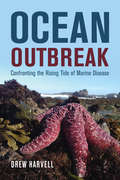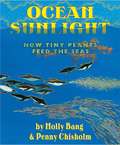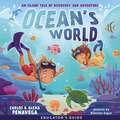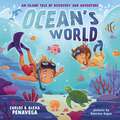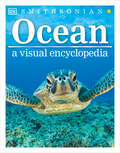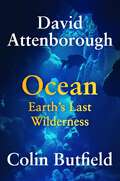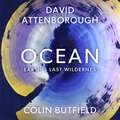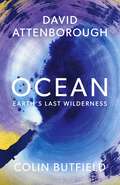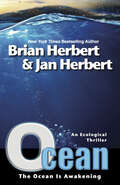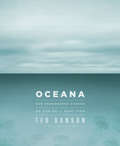- Table View
- List View
Ocean Activities for Kids: 20 Hands-On Projects to Explore the Sea (Science Scouts)
by Laura PetrusicInspire kids to explore like a scientist with an illustrated ocean activity guide for ages 8 to 12.Calling all ocean lovers: Are you ready to think like a scientist and adventure like an explorer? This fun and interactive guide shows you how to discover the seas with an active mind for learning. Travel down into the depths with 20 lessons and 20 activities that show you how different parts of the ocean work together, and explore all the unbelievable things the ocean does, such as moving with the moon, changing the shape of shorelines, and providing a home to millions of amazing creatures!Explore and play—See ocean science in action with fun experiments such as creating a tide pool, dissolving the earth's crust, simulating how jellyfish release their venom, and so much more.The 5 Science Scout skills—Practice the key skills that scientists and explorers use to discover the world as you Observe, Ask, Imagine, Test, and Reflect.Start an ocean journal—Use the journal pages and writing prompts to record your ideas and observations as you try the experiments—or create some marine memories if you visit the ocean yourself!Introduce curious kids to marine science and exploration with Ocean Activities for Kids—part of the Science Scouts series!
Ocean Anatomy Activities for Kids: Fun, Hands-On Learning (Anatomy Activities for Kids)
by Laura PetrusicExplore like a scientist with this illustrated ocean guide for kids ages 8 to 12 Dive into the big blue sea with Ocean Anatomy Activities for Kids! Travel around the world and down into the deep with illustrations and diagrams that show you how the different parts of the ocean work together. As you read about our amazing aquatic universe, you'll learn how to think like a marine scientist. Ocean Anatomy Activities for Kids goes beyond other marine biology books with: The world underwater—Discover 20 lessons that teach you about everything from kelp forests to coral reefs. Awesome activities—See ocean science in action with fun experiments like creating mini ocean currents and finding out what makes fish float. Your own ocean journal—Answer cool questions after each activity to figure out even more about what makes the ocean so special. Learn all about marine life as you journey the seas with this colorful kids' guide to ocean anatomy.
Ocean Beach: Fog, Fauna, and Flora
by Eddy RubinA charmingly illustrated nature guide to Ocean Beach and the coastal ecology of San Francisco.Grab your beach blanket and your puffy jacket (this is San Francisco, after all) and get ready to see Ocean Beach like never before. Longtime local surfer and scientist Eddy Rubin celebrates this magical sandy stretch through stories of its animals and plants and the natural and human forces that have shaped this coastal environment. From sand dollars and seaweed to the snowy plovers in the dunes, and stretching out to the seals and whales offshore, Rubin profiles twenty-nine local flora and fauna with wonder and curiosity. To explain the why and how, he also teaches readers about the weather and geological forces that have created this unique sandy ecology. Lifetime lovers of Ocean Beach and new neighbors alike will delight in Rubin's guide, brought vividly to life by more than forty full-color artworks by illustrator Greg Wright. With this guide, Rubin invites readers to explore the place where ocean and land meet, to learn from surfers and fishermen about what's out in the waves, and to protect this shared expanse of sandy shoreline.
Ocean Bestiary: Meeting Marine Life from Abalone to Orca to Zooplankton (Oceans In Depth Ser.)
by Richard J. KingA delightful A-to-Z menagerie of the sea—whimsically illustrated, authoritative, and thought-provoking. For millennia, we have taken to the waves. And yet, for humans, the ocean remains our planet’s most inaccessible region, the place about which we know the least. From A to Z, abalone to zooplankton, and through both text and original illustrations, Ocean Bestiary is a celebration of our ongoing quest to know the sea and its creatures. Focusing on individual species or groups of animals, Richard J. King embarks upon a global tour of ocean wildlife, including beluga whales, flying fish, green turtles, mako sharks, noddies, right whales, sea cows (as well as sea lions, sea otters, and sea pickles), skipjack tuna, swordfish, tropicbirds, walrus, and yellow-bellied sea snakes. But more than this, King connects the natural history of ocean animals to the experiences of people out at sea and along the world’s coastlines. From firsthand accounts passed down by the earliest Polynesian navigators to observations from Wampanoag clamshell artists, African-American whalemen, Korean female divers (or haenyeo), and today’s pilots of deep-sea submersibles—and even to imaginary sea expeditions launched through poems, novels, and paintings—Ocean Bestiary weaves together a diverse array of human voices underrepresented in environmental history to tell the larger story of our relationship with the sea. Sometimes funny, sometimes alarming, but always compelling, King’s vignettes reveal both how our perceptions of the sea have changed for the better and how far we still have to go on our voyage.
Ocean Counting: Odd Numbers (Jerry Pallotta's Counting Books)
by Jerry PallottaWith his trademark humor and wit, Jerry Pallotta teaches young readers how to count to 50 by odd numbers, using weird and wonderful ocean animals as counting tools. Explore the ocean as you meet 13 surf clams, 29 mussels, 49 smelts, and more.
Ocean Country
by Carl Safina Liz CunninghamOcean Country is an adventure story, a call to action, and a poetic meditation on the state of the seas. But most importantly it is the story of finding true hope in the midst of one of the greatest crises to face humankind, the rapidly degrading state of our environment. After a near-drowning accident in which she was temporarily paralyzed, Liz Cunningham crisscrosses the globe in an effort to understand the threats to our dazzling but endangered oceans. This intimate account charts her thrilling journey through unexpected encounters with conservationists, fishermen, sea nomads, and scientists in the Mediterranean, Sulawesi, the Turks and Caicos Islands, and Papua, New Guinea.From the Trade Paperback edition.ansform despair into strength and to discover what true hope is.
Ocean Energy and Coastal Protection: A Novel Strategy for Coastal Management Under Climate Change (SpringerBriefs in Energy)
by Rafael J. Bergillos Gregorio Iglesias Cristobal Rodriguez-DelgadoThis book presents the innovative concept of the dual function of wave farms as both renewable energy generators and coastal protection elements against erosion and flooding. Developing renewable energy is one of the most pressing targets for society in the coming decades due to the finite nature of fossil fuels, their high costs, and the environmental impacts of their exploration and use, including climate change and the subsequent sea-level rise. Wave energy is one of the most promising renewable energy sources, thanks to its huge potential and low impact on the environment. As such, this book discusses the development and application of artificial intelligence to optimise wave farm location and layout, assesses the influence of the wave energy converter geometry on coastal protection against erosion and flooding, and analyses how the performance of wave farms as coastal defence elements is affected by climate change and sea level rise. The concepts, methods and conclusions presented are helpful to students, researchers, academics, engineers, designers, stakeholders and managers around the globe interested in wave energy, coastal engineering, and coastal management.
Ocean Governance: Knowledge Systems, Policy Foundations and Thematic Analyses (MARE Publication Series #25)
by Anna-Katharina Hornidge Maria Hadjimichael Stefan PartelowThis Open Access book on Ocean Governance examines sustainability challenges facing our oceans today. The book is organized into three sections: knowledge systems, policy foundations and thematic analyses. The knowledge produced in the book was catalyzed by the scientific outcomes within the European-funded Cooperation in Science and Technology (COST) network “Ocean Governance for Sustainability – Challenges, Options and the Role of Science”. This network brings together scientists, policy-makers and civil society representatives from 28 nation states to cooperate on ocean governance research. This book offers a compilation of new research material including focused case studies, broad policy syntheses and reflective chapters on the history and current status of knowledge production systems on ocean governance. New research material is presented, although some chapters draw on secondary sources. The book starts with synthetic review chapters from the editors, outlining past and present knowledge systems, addressing how and why ocean governance for sustainability is where it currently stands with critical reflections on existing narratives, path dependencies and colonialist histories. This is followed by chapters addressing, synthesizing and analyzing different legal and policy frameworks for ocean governance both regionally and internationally. At the core of the book are the thematic analyses, which provide focused case studies with detailed contextual information in support of different ocean governance challenges and sustainability pathways around the world. The book concludes with a chapter explicitly targeting students, researchers and policy-makers with key take-away messages compiled by the editors.
Ocean Greens: Explore the World of Edible Seaweed and Sea Vegetables
by Lisette Kreischer Marcel SchuttelaarA 2017 IACP Award FinalistA beautifully photographed, innovative guide to edible seaweed and sea vegetables with vegan recipes—for your health and the planet’s “One of the world’s most sustainable and nutritious crops,” according to The New Yorker, “seaweed could be a miracle food.” It’s also been called “the new kale” (CNBC) and a “climate warrior” (Atlantic). On the cutting edge of food and sustainability, seaweed and sea vegetables are good both for you and—with the potential to drastically reduce our carbon footprint—for the planet. Now, Ocean Greens is the all-in-one guide to the most kitchen-ready varieties of this remarkable superfood (overflowing with nutrients!)—wakame, kombu, agar, samphire, nori, and many others. Seaweed visionaries Lisette Kreischer (dubbed a “fitfluencer” by Women’s Health) and Marcel Schuttelaar share insights on the nutrition, taste, and harvesting of each—as well as 50 irresistible vegan recipes that will have readers exclaiming, “I can’t believe it’s seaweed!” ·Pumpkin and Seaweed Pancakes ·Polenta Fries with Crunchy Sea Lettuce and Asparagus ·Seaweed Gnocchi with Spinach and Cherry Tomatoes ·Chocolate Chip and ’Weed Cookies, and more!
Ocean Life in the Time of Dinosaurs
by Peggy Vincent Nathalie Bardet Alexandra Houssaye Stéphane JouveA richly illustrated introduction to the spectacular reptiles that swam the oceans when dinosaurs roamed the landDuring the Mesozoic era, 252 to 66 million years ago, dinosaurs ruled the land, but the ocean deeps were roiling with equally spectacular reptiles—including giant predators. This richly illustrated, authoritative, and accessible book introduces readers to the world of these fascinating marine animals, whose predecessors returned to the seas a few million years after the first vertebrates emerged from the water. As we meet ichthyosaurs, plesiosaurs, mosasaurs, and many others, we learn about the astonishing anatomical, physiological, and behavioral adaptations that enabled these reptiles to become ocean dwellers again. We also learn about their living descendants, including sea turtles and sea snakes. Featuring stunning artwork depicting these prehistoric ocean creatures and photographs of their fossil remains, this book invites readers to discover the enthralling past of marine reptiles in all their extraordinary diversity.
Ocean Outbreak: Confronting the Rising Tide of Marine Disease
by Drew HarvellThere is a growing crisis in our oceans as rates of infectious disease outbreaks are on the rise. Marine epidemics have the potential to cause a mass die-off of wildlife from the bottom to the top of the food chain, impacting the health of ocean ecosystems as well as lives on land. Fueled by sewage dumping, unregulated aquaculture, and drifting plastic in warming seas, ocean outbreaks are sentinels of impending global environmental disaster. Ocean Outbreak follows renowned scientist Drew Harvell and her colleagues as they investigate how four iconic marine animals—corals, abalone, salmon, and starfish—have been devastated by disease. Based on over twenty years of research, this firsthand account of the sometimes creeping, sometimes exploding impact of disease on our ocean’s biodiversity ends with a hopeful message. Through policy changes and the implementation of innovative solutions from nature, we can reduce major outbreaks, save some ocean ecosystems, and protect our fragile environment.
Ocean Sunlight: How Tiny Plants Feed the Seas (Sunlight Series)
by Molly Bang Penny ChisholmIn this timely book, acclaimed Caldecott artist Molly Bang and award-winning M.I.T. professor Penny Chisholm use poetic language and dazzling illustrations to introduce the oceanic world. From tiny aquatic plants to the biggest whale or fish, Bang and Chisholm present a moving, living picture of the miraculous balance sustaining each life cycle and food chain deep within our wondrous oceans. <P><P>On land or in the deep blue sea, we are all connected--and we are all a part of a grand living landscape. Award-winning scientist Penny Chisholm, a leading expert on oceans, packs <i>Ocean Sunlight</i> with clear, simple science, illuminated by Molly Bang's wondrous illustrations. This informative, joyous book will help children understand and celebrate the astonishing role our oceans play in human life.
Ocean Sustainability in the 21st Century
by Salvatore AricòDescribing the emerging and unresolved issues related to the oceans and the marine environment, this book presents the developments made in marine science and policy since the implementation of the United Nations Convention on the Law of the Sea (UNCLOS), and implications for the sustainable management of ocean areas and resources. This comprehensive volume also provides a number of scientific, policy, and legal tools to address such issues, and to ensure better science-based management of the oceans. Topics covered include the impacts of human-induced climate change on the oceans, the marine genetic resources debate, the current legal framework for the oceans, and a comparative study of the legal issues associated with outer space. Including practical examples and worldwide case studies, this book is a valuable resource for policy makers, students and academics, in marine science and policy, ocean affairs, and the law of the sea.
Ocean of Insight: A Sailor's Voyage from Despair to Hope
by Heather Lyn MannHeather Lyn Mann was a battle-weary environmental advocate in Madison, Wisconsin, struggling over what to do about climate change when she and her husband decided to explore the Atlantic on a small sloop. This memoir of six years living afloat is a chronological unfolding of disasters and discoveries--life-threatening storms, the boredom of isolation, societies on the brink of extinction, sinking ships, colorful Caribbean characters, near collisions, a pirate scare, and more. Throughout, the ocean becomes Mann's teacher, transforming her with uncompromising lessons on how to harmonize with natural order, the exact moments and ways to let in fearlessness, resilience, happiness, impermanence, balance, compassion, skillful action, and beginner's mind. Her suspenseful, sometimes hilarious, and always heart-warming journey of body and mind, shaped by ancient Buddhist teachings, entertains as it charts reality's depths and danger zones so arm-chair adventurers, spiritual seekers, and the climate concerned can navigate tumultuous waters and arrive together on the shore of planetary well-being.From the Trade Paperback edition.
Ocean of Trade
by Pedro MachadoOcean of Trade offers an innovative study of trade, production and consumption across the Indian Ocean between the years 1750 and 1850. Focusing on the Vāniyā merchants of Diu and Daman, Pedro Machado explores the region's entangled histories of exchange, including the African demand for large-scale textile production among weavers in Gujarat, the distribution of ivory to consumers in Western India, and the African slave trade in the Mozambique channel that took captives to the French islands of the Mascarenes, Brazil and the Rio de la Plata, and the Arabian peninsula and India. In highlighting the critical role of particular South Asian merchant networks, the book reveals how local African and Indian consumption was central to the development of commerce across the Indian Ocean, giving rise to a wealth of regional and global exchange in a period commonly perceived to be increasingly dominated by European company and private capital.
Ocean's World Educator's Guide: An Island Tale of Discovery and Adventure (Ocean’s World)
by Carlos PenaVega Alexa PenaVegaOcean's World Educator's Guide is a companion to Ocean's World: An Island Tale of Discovery and Adventure by Carlos PenaVega and Alexa PenaVega. This guide can be utilized in the classroom, in a home school setting, or by parents seeking additional resources. Ideal for ages 4-8.
Ocean's World: An Island Tale of Discovery and Adventure (Ocean’s World)
by Carlos PenaVega Alexa PenaVegaJoin Ocean and Kingston as they explore the ocean, discover wildlife, and learn fascinating marine facts in Ocean's World, an action and adventure story for kids!Ocean and his little brother, Kingston, explore the beautiful island of Maui in search of a sunrise shell for their mom&’s birthday gift. But with a rumbling volcano and so much to unearth, will the boys ever find the special shell?Celebrity couple Carlos and Alexa PenaVega, known for their starring roles in Big Time Rush and Spy Kids, respectively, debut their first picture book, inspired by their firstborn son, Ocean, and their home in Hawaii.As Ocean and Kingston's adventure unfolds, you'll encounter so many fun and educational surprises along the way! During their journey you'll learnhow high a dolphin can jump;how long it takes for a sea-turtle egg to hatch;different types of shells including the cone, cowrie, puka, and Triton&’s trumpet; andtypes of animals in the ocean. Whether they're surfing the waves, scouring the beach, or snorkeling in the tide pools, Ocean and Kingston are determined to learn everything the island can teach them.With lively illustrations and sea-sational facts, Ocean's Worldis ideal for kids 4 to 8, especially fans of Octonauts or Magic School Bus;is a perfect gift for baby showers, Christmas, or birthdays, as well as a just-because gift for curious kids; andfits on a child's lap or in a gift basket.Kids will so love exploring the island and ocean--and all the wonders they have to offer--that they won't want their island adventure to end!
Ocean: A Visual Encyclopedia (DK Children's Visual Encyclopedias)
by John Woodward DKFrom the shimmering surface to the darkest depths, this breathtaking visual encyclopedia presents our blue planet as never before. Stunning photography, accessible information, and fascinating facts are spilling over in this essential guide to the oceans. Take a dip in all the world&’s waters to experience their incredible diversity. Make a splash in the icy Arctic waters before warming up in the tropical Indian Ocean. Experience the super size of mighty whales compared to swarms of tiny krill. Cast your eyes to the skies to see circling sea birds before diving down to meet mysterious creatures of the deep. Awash with comprehensive information and fascinating detail, Ocean: A Children&’s Encyclopedia is the perfect choice for school projects, marine enthusiasts, and water babies everywhere.
Ocean: Dive in and Discover the World Beneath the Waves (Earth's Incredible Habitats)
by Annie RothTake children on a grand tour of the marine world in this striking book all about oceans. From the deepest known sea trench on Earth to the underwater forests that make their home in the Pacific Ocean, discover 10 of the world’s most spectacular ocean habitats, and the animals and plants that live in them in this beautiful gift book for children.This fascinating book on oceans offers:The second in a series of 4 books that takes children on a grand tour around the different habitats of the world.Everything you could want to know about habitats; the animals and plants that live there, the geography of the area, and plenty of incredible factsA giftable book with foil on the cover and edges, plus beautiful illustrations and photographs on every page.The chapters in this exciting anthology cover four different types of ocean habitat: open oceans, coral reefs, underwater forests, and the deep sea, with a selection of both famous and lesser-known places explored. Every marine environment is examined in detail, with intriguing information about its geography, and flora and fauna alongside detailed photography and beautiful illustrations. Children can marvel at fire coral in the Red Sea, sea spiders that thrive in the ghostly quiet of the Southern Ocean, and sea anemones that can live forever. As well as the wonders of these places, the threats facing oceans and their species are also investigated.More in the seriesThe Habitats series takes children on a grand tour of the different natural environments of the world, exploring animals, landforms and geography. If you enjoyed Ocean, why not try Mountain and learn about some of the earth’s most incredible landforms and the science behind them?
Ocean: Earth's Last Wilderness
by Sir David Attenborough Colin ButfieldAward-winning broadcaster and natural historian David Attenborough and longtime collaborator Colin Butfield present a powerful call to action focused on our planet's oceans, exploring how critical this habitat is for the survival of humanity and the earth's future. Through personal stories, history and cutting-edge science, Ocean uncovers the mystery, the wonder, and the frailty of the most unexplored habitat on our planet—the one which shapes the land we live on, regulates our climate, and creates the air we breathe. This book showcase the oceans' remarkable resilience: they can, and in some cases have, recovered the fastest, if we only give them the chance. Drawing a course across David Attenborough's own lifetime, Ocean takes readers on an adventure-laden voyage through eight unique ocean habitats, countless intriguing species, and the most astounding discoveries of the last 100 years, to a future vision of a fully restored marine world—one even more spectacular than we could possibly hope for. Ocean reveals the past, present and potential future of our blue planet. It is a book almost a century in the making, but one that has never been more urgently needed.
Ocean: Earth's Last Wilderness - THE LANDMARK NEW BOOK BY DAVID ATTENBOROUGH
by Sir David Attenborough Colin Butfield'This is the story of our ocean and we must write its next chapter together. For if we save the sea, we save our world. After a lifetime of filming our planet, I'm sure that nothing is more important.'From the icy seas of our poles to remote coral islands, David Attenborough has filmed in every ocean habitat on planet earth. Now, with long-term collaborator Colin Butfield, he shares the story of our last great wilderness - the one which shapes the land we live on, regulates our climate and creates the air we breathe.Dive into eight unique saltwater habitats, swim through kelp forest, mangroves and coral reefs and down almost 11,000 feet to the deepest corners of the most unexplored ecosystem on our planet.Experience a journey of wonder and discovery, populated by green turtles and blue whales; clownfish and bioluminescent jellyfish; the vampire squid and the 'head-less chicken monster' - a strange form of sea cucumber that lives at the very bottom of the ocean.With the warmth, intelligence and awe that characterises all of David Attenborough's landmark series, Ocean shows us a world which is both desperately fragile yet astonishingly resilient, with an extraordinary capacity to repair itself. It's not too late to restore our most vital habitat. If we treat it with respect, our marine world will be even richer and more spectacular than we can imagine.A book almost a century in the making, but one that has never been more urgently needed.
Ocean: Earth's Last Wilderness - THE LANDMARK NEW BOOK BY DAVID ATTENBOROUGH
by Sir David Attenborough Colin Butfield** THE INSTANT SUNDAY TIMES BESTSELLER **'Gripping... the wildlife is so fantastical that the images on the page feel like works of the imagination.' Evening Standard'THIS IS THE STORY OF OUR OCEAN AND WE MUST WRITE ITS NEXT CHAPTER TOGETHER. FOR IF WE SAVE THE SEA, WE SAVE OUR WORLD. AFTER A LIFETIME OF FILMING OUR PLANET, I'M SURE THAT NOTHING IS MORE IMPORTANT.'From the icy seas of our poles to remote coral islands, David Attenborough has filmed in every ocean habitat on planet earth. Now, with long-term collaborator Colin Butfield, he shares the story of our last great wilderness - the one which shapes the land we live on, regulates our climate and creates the air we breathe.Dive into eight unique saltwater habitats, swim through kelp forests, mangroves and coral reefs and down almost 11,000 feet to the deepest corners of the most unexplored ecosystem on our planet.Experience a journey of wonder and discovery, populated by green turtles and blue whales; clownfish and bioluminescent jellyfish; the vampire squid and the 'head-less chicken monster' - a strange form of sea cucumber that lives at the very bottom of the ocean.With the warmth, intelligence and awe that characterises all of David Attenborough's landmark series, Ocean shows us a world which is both desperately fragile yet astonishingly resilient, with an extraordinary capacity to repair itself. It's not too late to restore our most vital habitat. If we treat it with respect, our marine world will be even richer and more spectacular than we can imagine.A book almost a century in the making, but one that has never been more urgently needed.
Ocean: Reflections on a Century of Exploration
by Wolf H. BergerThe past one hundred years of ocean science have been distinguished by dramatic milestones, remarkable discoveries, and major revelations. This book is a clear and lively survey of many of these amazing findings. Beginning with a brief review of the elements that define what the ocean is and how it works--from plate tectonics to the thermocline and the life within it--Wolf H. Berger places current understanding in the context of history. Essays treat such topics as beach processes and coral reefs, the great ocean currents off the East and West Coasts, the productivity of the sea, and the geologic revolution that changed all knowledge of the earth in the twentieth century.
Ocean: The Ocean Cycle Omnibus
by Brian Herbert Jan HerbertFrom a New York Times–bestselling author, an ecological thriller about human animal hybrids battling to rescue the ocean from environmental impact. In 2024, Earth is consumed by a great War of Ocean Liberation: a military force of sea creatures attacks naval installations, shuts down shipping lanes and fishing operations, and destroys offshore oil-drilling rigs. Huge blue whales, sharks, dolphins, and even monstrous creatures thought to be extinct—all strike with ferocity and surprising strength. The marine armada is led by hybrid, transformed humans who call themselves Sea Warriors, ocean-rights zealots who can swim to the deepest regions of the sea and live off the bounty of the waters. Their commander, Kimo Pohaku, announces his startling intention: The complete liberation of the seas from human control. Finally, the ocean is fighting back, but it might be too late . . .
Oceana: Our Endangered Oceans and What We Can Do to Save Them
by Ted Danson Mike D'OrsoMost people know Ted Danson as the affable bartender Sam Malone in the long-running television series Cheers. But fewer realize that over the course of the past two and a half decades, Danson has tirelessly devoted himself to the cause of heading off a looming global catastrophe—the massive destruction of our planet's oceanic biosystems and the complete collapse of the world's major commercial fisheries. In Oceana, Danson details his journey from joining a modest local protest in the mid-1980s to oppose offshore oil drilling near his Southern California neighborhood to his current status as one of the world's most influential oceanic environmental activists, testifying before congressional committees in Washington, D.C.; addressing the World Trade Organization in Zurich, Switzerland; and helping found Oceana, the largest organization in the world focused solely on ocean conservation.In his incisive, conversational voice, Danson describes what has happened to our oceans in just the past half-century, ranging from the ravages of overfishing and habitat destruction to the devastating effects of ocean acidification and the wasteful horrors of fish farms. Danson also shares the stage of Oceana with some of the world's most respected authorities in the fields of marine science, commercial fishing, and environmental law, as well as with other influential activists.Combining vivid, personal prose with an array of stunning graphics, charts, and photographs, Ocean powerfully illustrates the impending crises and offers solutions that may allow us to avert them, showing you the specific courses of action you can take to become active, responsible stewards of our planet's most precious resource—its oceans.
